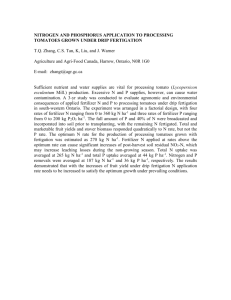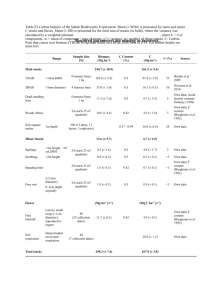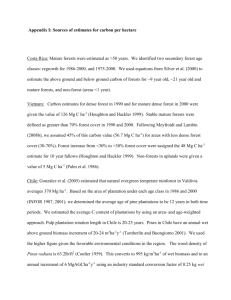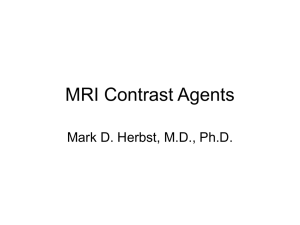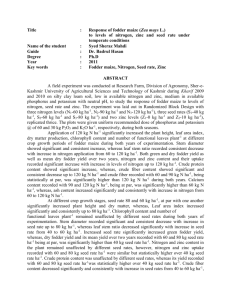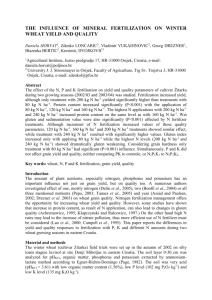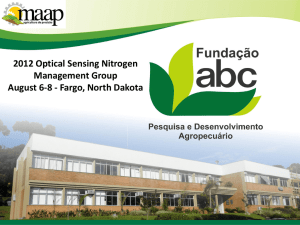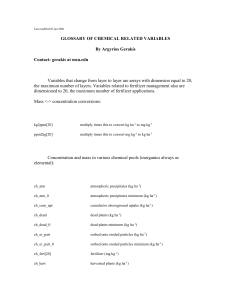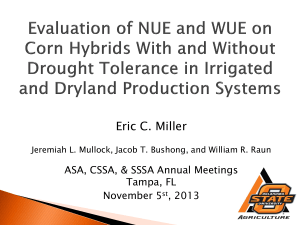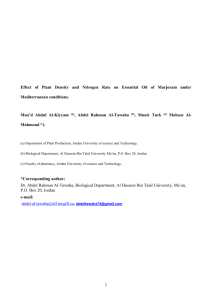The Nitrogen Requirement and Use Efficiency of Sweet
advertisement
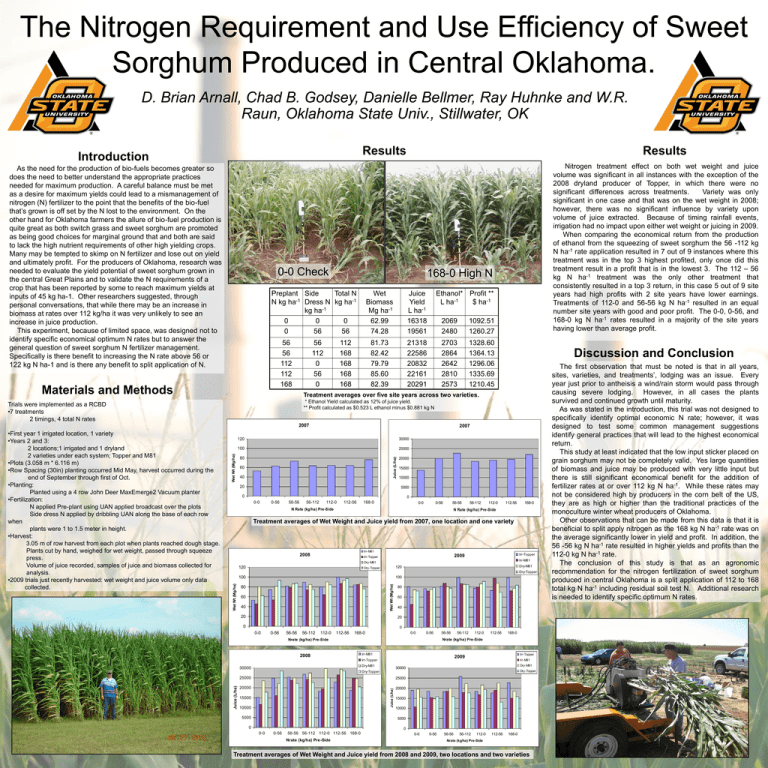
The Nitrogen Requirement and Use Efficiency of Sweet Sorghum Produced in Central Oklahoma. D. Brian Arnall, Chad B. Godsey, Danielle Bellmer, Ray Huhnke and W.R. Raun, Oklahoma State Univ., Stillwater, OK Results Introduction As the need for the production of bio-fuels becomes greater so does the need to better understand the appropriate practices needed for maximum production. A careful balance must be met as a desire for maximum yields could lead to a mismanagement of nitrogen (N) fertilizer to the point that the benefits of the bio-fuel that’s grown is off set by the N lost to the environment. On the other hand for Oklahoma farmers the allure of bio-fuel production is quite great as both switch grass and sweet sorghum are promoted as being good choices for marginal ground that and both are said to lack the high nutrient requirements of other high yielding crops. Many may be tempted to skimp on N fertilizer and lose out on yield and ultimately profit. For the producers of Oklahoma, research was needed to evaluate the yield potential of sweet sorghum grown in the central Great Plains and to validate the N requirements of a crop that has been reported by some to reach maximum yields at inputs of 45 kg ha-1. Other researchers suggested, through personal conversations, that while there may be an increase in biomass at rates over 112 kg/ha it was very unlikely to see an increase in juice production. This experiment, because of limited space, was designed not to identify specific economical optimum N rates but to answer the general question of sweet sorghum N fertilizer management. Specifically is there benefit to increasing the N rate above 56 or 122 kg N ha-1 and is there any benefit to split application of N. Results 0-0 Check 168-0 High N Preplant Side Total N N kg ha-1 Dress N kg ha-1 kg ha-1 0 0 0 0 56 56 56 56 112 112 168 Materials and Methods 56 112 0 56 0 112 168 168 168 168 Wet Biomass Mg ha-1 62.99 74.28 Juice Yield L ha-1 16318 19561 81.73 82.42 79.79 85.60 82.39 21318 22586 20832 22161 20291 Ethanol* Profit ** L ha-1 $ ha-1 2069 2480 1092.51 1260.27 2703 2864 2642 2810 2573 1328.60 1364.13 1296.06 1335.69 1210.45 Discussion and Conclusion Treatment averages over five site years across two varieties. * Ethanol Yield calculated as 12% of juice yield. ** Profit calculated as $0.523 L ethanol minus $0.881 kg N Trials were implemented as a RCBD •7 treatments 2 timings, 4 total N rates 2007 120 30000 100 25000 80 20000 Juice (L/ha) Wet Wt (Mg/ha) 2007 60 40 15000 10000 20 5000 0 0 0-0 0-56 56-56 56-112 112-0 112-56 168-0 0-0 0-56 56-56 N Rate (kg/ha) Pre-Side 56-112 112-0 112-56 168-0 N Rate (kg/ha) Pre-Side Treatment averages of Wet Weight and Juice yield from 2007, one location and one variety Irr-M81 2008 Irr-Topper 2009 Irr-Topper Irr-M81 Dry-M81 120 Dry-M81 120 Dry-Topper Dry-Topper 100 Wet Wt (Mg/ha) Wet Wt (Mg/ha) 100 80 60 40 80 60 40 20 20 0 0 0-0 0-56 56-56 56-112 112-0 112-56 168-0 0-0 0-56 2008 56-56 Irr-M81 112-0 112-56 168-0 Irr-Topper 2009 Irr-Topper Dry-M81 30000 56-112 Nrate (kg/ha) Pre-Side Nrate (kg/ha) Pre-Side Irr-M81 Dry-M81 30000 Dry-Topper Dry-Topper 25000 25000 20000 20000 Juice (L/ha) Juice (L/ha) •First year 1 irrigated location, 1 variety •Years 2 and 3: 2 locations;1 irrigated and 1 dryland 2 varieties under each system; Topper and M81 •Plots (3.058 m * 6.116 m) •Row Spacing (30in) planting occurred Mid May, harvest occurred during the end of September through first of Oct. •Planting: Planted using a 4 row John Deer MaxEmerge2 Vacuum planter •Fertilization: N applied Pre-plant using UAN applied broadcast over the plots Side dress N applied by dribbling UAN along the base of each row when plants were 1 to 1.5 meter in height. •Harvest: 3.05 m of row harvest from each plot when plants reached dough stage. Plants cut by hand, weighed for wet weight, passed through squeeze press. Volume of juice recorded, samples of juice and biomass collected for analysis. •2009 trials just recently harvested: wet weight and juice volume only data collected. Nitrogen treatment effect on both wet weight and juice volume was significant in all instances with the exception of the 2008 dryland producer of Topper, in which there were no significant differences across treatments. Variety was only significant in one case and that was on the wet weight in 2008; however, there was no significant influence by variety upon volume of juice extracted. Because of timing rainfall events, irrigation had no impact upon either wet weight or juicing in 2009. When comparing the economical return from the production of ethanol from the squeezing of sweet sorghum the 56 -112 kg N ha-1 rate application resulted in 7 out of 9 instances where this treatment was in the top 3 highest profited, only once did this treatment result in a profit that is in the lowest 3. The 112 – 56 kg N ha-1 treatment was the only other treatment that consistently resulted in a top 3 return, in this case 5 out of 9 site years had high profits with 2 site years have lower earnings. Treatments of 112-0 and 56-56 kg N ha-1 resulted in an equal number site years with good and poor profit. The 0-0, 0-56, and 168-0 kg N ha-1 rates resulted in a majority of the site years having lower than average profit. 15000 10000 15000 10000 5000 5000 0 0 0-0 0-56 56-56 56-112 112-0 112-56 168-0 Nrate (kg/ha) Pre-Side 0-0 0-56 56-56 56-112 112-0 112-56 168-0 Nrate (kg/ha) Pre-Side Treatment averages of Wet Weight and Juice yield from 2008 and 2009, two locations and two varieties The first observation that must be noted is that in all years, sites, varieties, and treatments’, lodging was an issue. Every year just prior to antheisis a wind/rain storm would pass through causing severe lodging. However, in all cases the plants survived and continued growth until maturity. As was stated in the introduction, this trial was not designed to specifically identify optimal economic N rate; however, it was designed to test some common management suggestions identify general practices that will lead to the highest economical return. This study at least indicated that the low input sticker placed on grain sorghum may not be completely valid. Yes large quantities of biomass and juice may be produced with very little input but there is still significant economical benefit for the addition of fertilizer rates at or over 112 kg N ha-1. While these rates may not be considered high by producers in the corn belt of the US, they are as high or higher than the traditional practices of the monoculture winter wheat producers of Oklahoma. Other observations that can be made from this data is that it is beneficial to split apply nitrogen as the 168 kg N ha-1 rate was on the average significantly lower in yield and profit. In addition, the 56 -56 kg N ha-1 rate resulted in higher yields and profits than the 112-0 kg N ha-1 rate. The conclusion of this study is that as an agronomic recommendation for the nitrogen fertilization of sweet sorghum produced in central Oklahoma is a split application of 112 to 168 total kg N ha-1 including residual soil test N. Additional research is needed to identify specific optimum N rates.
